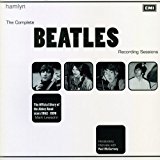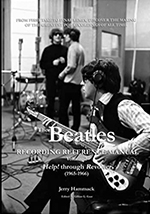Location
Recording studio: CTS Studios, London, 47-53 Kensington Garden Square, London, UK
Timeline
Previous session December 1965 ? • Recording "Unforgettable", the unreleased Christmas album
Interview Jan 01, 1966 • Paul McCartney interview for Disc And Music Echo
Interview Jan 01, 1966 • Paul McCartney interview for Melody Maker
Session Jan 05, 1966 • Recording overdubs for "The Beatles At Shea Stadium" TV special
Single Jan 10, 1966 • "Woman / Wrong From The Start" by Peter and Gordon released in the US
Article Jan 21, 1966 • Paul McCartney attends George Harrison's wedding with Patty Boyd
Next session Apr 06, 1966 • Recording "Tomorrow Never Knows"
The Beatles’ concert at New York’s Shea Stadium on August 15, 1965, had been professionally filmed – no less than fourteen cameras had been used to capture the euphoria and mass hysteria that was Beatlemania in the USA in 1965. But the Beatles’ performance was negatively impacted by their inability to hear themselves due to the loud screams of the 55,600 fans in attendance. Also, the sound quality of the recordings made using mobile recording facilities was below standard.
As NEMS Enterprises, via the Beatles company Subafilms, wanted to produce a TV special around this special concert, The Beatles, on this day, went to CTS (CineTeleSound) Studios, a film-dubbing studio, to overdub some instrument parts onto the live tracks.
Paul McCartney recorded new bass parts for “Dizzy Miss Lizzy,” “Can’t Buy Me Love,” “Baby’s In Black,” and “I’m Down,” while John Lennon added a new organ track to the latter song.
The Beatles re-recorded “I Feel Fine” and “Help!” from scratch because the quality of the concert recordings couldn’t be improved, but they made sure to capture the live feel of the songs and match the music to the on-screen images.
They may have recorded some overdubs for “Ticket To Ride“, but they were not used on the TV Special.
There wasn’t enough time to improve “Twist And Shout” or “Act Naturally“. For “Twist And Shout“, the recording of their August 30, 1965, Hollywood Bowl concert was used instead. For “Act Naturally“, the studio version was used, with some additional crowd noise added.
“She’s a Woman” and “Everybody’s Trying to Be My Baby” were not included in the TV Special and no work was done on them.
[…] To fix Act Naturally the Beatles did nothing: the film’s post-production team merely replaced the Shea recording with the Beatles’ disc version (recorded 17 June 1965), sync-ing it to the picture by means of audience cutaways and even, in places, cuts in the music. (Intentionally or otherwise, one moment – where Ringo’s vocal is evident but his mouth is closed – was left in the film uncorrected.)
Documentation also suggests that John wished to record a new version of Ticket To Ride, and that it was done during this CTS session, but close study of the film indicates that the original Shea version was used (although perhaps a little instrumental overdubbing was effected).
Additionally, George Martin desired a new recording of Twist And Shout, but there wasn’t time to do this. Instead, the post-production team used the unreleased 30 August 1965 Hollywood Bowl concert recording to bolster the sound, causing – in one place – John’s live vocal to be double – tracked. In fact, the Bowl recording was used extensively during the film’s post-production processes for recordings of the screaming audience, especially on the two all-new London recordings.
No doctoring appears to have been done to either She’s A Woman or Everybody’s Trying To Be Baby, suggesting that, by this time, they had already been excluded from the film. They were, however, included in an early print which Epstein received from Sullivan Productions around 5 November 1965, which then ran to 54 minutes. By January, as it would be for the transmission, the film’s duration had been cut to just under 48 minutes. […]
From “The Complete Beatles Chronicles“, by Mark Lewisohn, 2004
George Martin and I sat at CTS (Cine Tele Sound), postsynch studios in Kensington Gardens Square, in Bayswater, and watched the Shea Stadium footage. The visuals were good but the sound was awful. The Beatles’ own amps were top of the line, but still not powerful enough. To compound the problems, they couldn’t hear themselves against the noise of the crowd and were out of tune and out of time. When we finished watching, George said, “Oh dear.”
I said, “You’re right. The pictures are good, but the soundtrack sucks. We could redo the music sound to picture and synch it.” It was standard movie technique to “loop” actors’ dialogue if, for instance, the wind on the set or a passing plane drowned out their voices.
I knew that George was thinking. But would EMI permit this? It was one thing for a concert to be filmed live, it was another thing for the Beatles to go into the studio and cut new tracks. In simple terms, it raised thorny issues about the Beatles’ exclusive recording contract with EMI. We talked it quietly through. I said, “If we take this problem to EMI, they will agonize for months and the BBC want to broadcast it on the first of March. The other thing is, even if we do redo it, no one must know. This is being sold as an ‘original soundtrack.’ ”
George Martin was always pragmatic. If a thing needed to be done, it got done. “Right,” he said. “There might be union problems too. They are making a big issue over miming and dubbing live performances.”
I must admit I was a bit surprised that he had gone to the heart of the problem so quickly, and didn’t refuse to take a risk, because I always saw him as very establishment. He had patrician good looks—in fact, at the fancy dress parties, which were quite the craze then, he and his wife, Judy, always dressed up as Prince Philip and the queen, and looked every inch the part. I had always liked and admired him very much. He was very gentle, well-read and knowledgeable, not a snob in any way despite running an important record label, and had a keen sense of humor. Now, I warmed to him.
We arranged a date for the Beatles to come in and a schedule to work from. I stressed that no one must know, and it was all very hush-hush, which intrigued them. […]
As they filed into CTS with their instruments, I said, “Don’t forget, act naturally.” They were amused. This was the title of one of Ringo’s songs in the Shea Stadium set.
“So what’s this all about, Tone?” Ringo asked.
“You have to lay down a new soundtrack, sound to picture,” I said. I explained the problems and they were quick to grasp what had to be done, and why it had to be secret. “If anyone asks, the story is that the soundtrack has been sweetened,” I said, adding, “think ‘Honey Pie.’ ”
“Sounds like ‘money pie’ to me,” said John.
We re-recorded all the songs for the final version of the film, close-synching it all carefully to match the picture, frame by frame. Ringo didn’t sing at all in the overdubs, because “Act Naturally” was impossible to do again to picture. It was recorded again later at Abbey Road and issued as a single. George’s “Everybody’s Trying to Be My Baby” and Paul’s “She’s a Woman” were bad visually and orally and were cut altogether. We ran out of time to do John’s “Twist and Shout,” because postsynching is a very boring and time-consuming process and John was fed up with the time it was taking.
“I’ve got a party to go to,” he said.
George Martin and Paul thought we should try to carry on and tried to persuade him to stay, but he was adamant and left to go to one of P. J. Proby’s wild events in Chelsea. The others shrugged, packed up their gear and left as well. George Martin and I stayed to dub a few more things. I enjoyed spending time with him because he really was very pleasant and easy to work with. We found the final tapes of the Beatles at Hollywood Bowl concert from the year before and overdubbed some of the audience’s screaming in the right places. The film ended up forty-eight minutes long, cut by eight minutes and I took it to the labs for processing.
Tony Bramwell – From “Magical Mystery Tours: My Life with the Beatles“, 2005
When the Beatles came to view the finished work, they were amazed by the quality of the film. It was very pretty, with lots of edited-in footage of them in the helicopter, flying over New York on the way to Shea, and them backstage chatting. The sound was brilliant. The synchs and overdubs, seamless. We never told the Ed Sullivan people, or anyone else.
Tony Bramwell – From “Magical Mystery Tours: My Life with the Beatles“, 2005
The TV Special, simply entitled “The Beatles At Shea Stadium” was screened for the first time on March 1, 1966, on BBC1.
SHEA STADIUM CONCERT
A threequarters of an hour film on the boys’ performances at the Shea Stadium in New York on August 15 last year, is due to be shown on Television early in March. When the Beatles arrived at the studio to add some of the sound track, which had been too muffled when the film was actually shot, they found that they had no instruments. So they rang up Sound City in London and a complete set of Beatles Guitars and amplifiers was sent round within the hour.
From The Beatles Monthly Book – February 1966

Session activities
-
Written by Larry Williams
Recording
-
Recording
-
Recording
-
Recording
-
Recording
-
Recording
-
Recording • The Beatles may have recorded some overdubs for “Ticket To Ride“, but they were not used on the TV Special.
Staff
Musicians on "Can't Buy Me Love"
- Paul McCartney : Bass
Musicians on "Baby's In Black"
- Paul McCartney : Bass
Musicians on "Help!"
- Paul McCartney : Performed by
- Ringo Starr : Performed by
- John Lennon : Performed by
- George Harrison : Performed by
Musicians on "Dizzy Miss Lizzy"
- Paul McCartney : Bass
Musicians on "I Feel Fine"
- Paul McCartney : Performed by
- Ringo Starr : Performed by
- John Lennon : Performed by
- George Harrison : Performed by
Musicians on "I'm Down"
- Paul McCartney : Bass
- John Lennon : Organ


